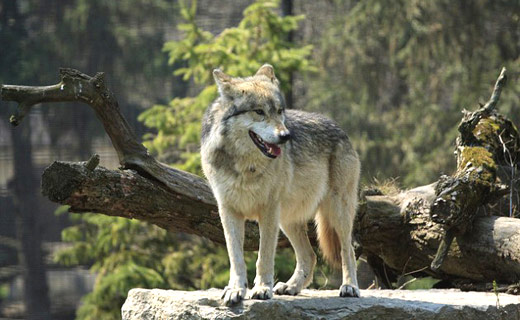
After announcing on Jul. 24 the onset of the wolf hunting and trapping season, the Minnesota Department of Natural Resources (DNR) announced it would issue 500 more licenses than last year, and increase the number of wolves that could be killed by nearly 14 percent. At a time when wolves throughout the U.S. are endangered, and only just starting to make a comeback in some states, these actions have fueled a climate of concern and outrage amongst animal rights activists and environmentalists, for some important reasons.
The state DNR has overall made 3,800 licenses available for 2014, and will allow up to 250 wolves to be killed (an uptick from last year’s 220), before the season’s closure. The basis for the increase is the DNR’s apparent estimate that the Minnesota gray wolf population is “stable, with no significant change from the 2013 estimate.” This can be seen as something of a logical fallacy, as what occurs amongst the wolf population in one state has a ripple effect on that of another. In fact, the Wisconsin DNR issued a report in April this year, noting that there was a 19 percent decrease in that state’s wolf population in 2013 – notably, after hunting permits in that state were doubled during the fall of that year, but also likely affected by hunting in neighboring states as well.
Maureen Hackett, a founder of Howling for Wolves, a conservational wolf advocacy group, said that the bottom line is “people need to know that no matter what they say, the [Minnesota] DNR clearly doesn’t have the best interest of wolves in mind, to be having another season, with more wolves killed, so quickly after they were on the endangered species list. The DNR has no idea what kind of mortality [rate] wolves are seeing for poaching and vehicles, or other problems – so they really don’t know how many wolves are out there.”
Though some argue that the expansion of wolves into other U.S. states is a sign that they are no longer endangered, Hackett suggested that conclusion is not quite logical, either. She remarked that shooting or trapping individual wolves “disrupts the pack’s social order” and causes the individual members to disperse. It’s probable that this is a key component in their wandering into long-uninhabited territory. And those stray wolves are not faring well. In August 2013, the first wolf in 150 years was found in Kentucky, and then promptly shot and killed by a hunter, who had mistaken it for a coyote.
A common argument made by wolf-hunting supporters is that the animals prey heavily upon white-tailed deer, negatively affecting the population, but this is largely untrue. In fact, deer are overpopulated, and this itself is at least partly a byproduct of wild wolf depletion, and is furthermore causing ecological problems. Some animal welfare advocates were up in arms after an 11 year-old Michigan hunter killed an albino deer this month while on a hunting trip with his father. But the truth is, aside from that animal’s unique color, the incident was inconsequential; deer across the U.S. are still growing in troubling numbers despite hunting.
According to Nature World News, a recent study conducted by researchers at Cornell University found that the rise in deer populations is contributing to long-term deforestation, as the animals’ grazing habits are preventing trees and other plants from maturing. Anurag Agrawal, Cornell professor of ecology and evolutionary biology who was one of the authors of the study, said, “Deer are slowing down forest succession or natural establishment. In fact, the deer are preventing forests from establishing.” This is because deer prefer to eat the seeds of native woody plants (trees and shrubbery), and do so in vast numbers while rejecting those found in invasive plants (mostly weeds).
Native Americans, meanwhile, have also spoken out against the wolf killing, as Peter David, biologist with the Great Lakes Indian Fish and Wildlife Commission (GLIFWC) pointed out. “Tribes feel strongly that wolves provide real benefits, both ecologically and spiritually,” he said. “The state’s actions have greatly diminished those benefits. The tribes have great concerns about what is happening to the wolf.”
James Zorn, executive administrator of GLIFWC, concluded, “We understand wolves to be educators, teaching us about hunting and working together in extended family units. We oppose wolf hunts. Wolves exemplify perseverance, guardianship, intelligence, and wisdom.”
Photo: AP

MOST POPULAR TODAY

Zionist organizations leading campaign to stop ceasefire resolutions in D.C. area

High Court essentially bans demonstrations, freedom of assembly in Deep South

UN warns that Israel is still blocking humanitarian aid to Gaza

Communist Karol Cariola elected president of Chile’s legislature

U.S. imperialism’s ‘ironclad’ support for Israel increases fascist danger at home






Comments